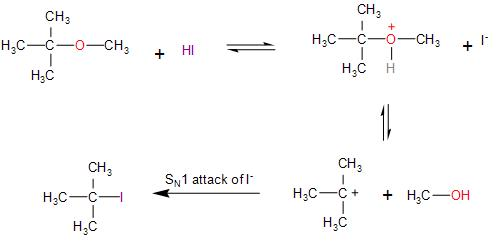Question
Question: Among the following ethers, which one will produce methyl alcohol on treatment with hot concentrated...
Among the following ethers, which one will produce methyl alcohol on treatment with hot concentrated HI?
(A)- CH3−CH2−CH2−CH2−O−CH3
(B)- CH3−CH2−CH(CH3)−O−CH3
(C)- CH3−C(CH3)2−O−CH3
(D)- CH3−CH(CH3)−CH2−O−CH3
Solution
The strong concentrated acid causes the cleavage of the C-O bond in the ether, followed by the nucleophilic substitution reaction to form the alcohol and the alkyl halide. This substitution further depends on the stability of the carbocation formed in the higher degree of alkyl groups.
Complete step by step solution:
The reaction of ether with the strong hydriodic acid (HI), which causes the cleavage of the ether C-O bond, following the nucleophilic substitution reaction. This cleavage further depends on the degree of alkyl group present on the ether as the primary and the secondary alkyl ethers having less steric hindrance. Thus, shows the SN2 mechanism.
So, in compound (A), through the SN2 mechanism, having 1∘ alkyl group, on reaction with HI, it forms butanol and methyl iodide.
Similarly, in compound (D), on reaction with HI, it forms 2-methyl propanol and methyl iodide.
In compound (B), having a 2∘ alkyl group, on reaction it forms methyl iodide and isobutyl alcohol.
Whereas in case of the tertiary alkyl ether due to steric hindrance it follows the SN1 mechanism through the formation of the stable carbocation intermediate. So, in compound (C), on reaction we get tertiary- butyl iodide and methanol. As follows:

Therefore, the option (C)- CH3−C(CH3)2−O−CH3 ether will produce methyl alcohol on treatment with hot concentrated HI.
Note: It must be noted that in the primary and the secondary alkyl ethers, following the SN2 mechanism, due to less hindrance, the iodide attaches to the smaller alkyl group, whereas in the tertiary alkyl ether following the SN1 mechanism, the high stability of the tertiary carbocation the iodide attaches to it, and the smaller alkyl forms the alcohol.
